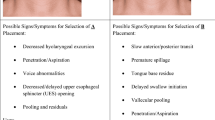Abstract
Given the paucity of objective information on neuromuscular electrical stimulation approaches to dysphagia therapy, and the expanding utilization of this clinical approach, we designed and conducted two surveys to gather large-scale information regarding reported practice patterns, outcomes, complications, and professional perceptions associated with electrical stimulation approaches to dysphagia therapy. Self-administered questionnaires were mailed to 1000 randomly selected speech-language pathologists in each of two groups: (1) clinicians who had completed a formal electrical stimulation training course and were actively using these techniques, and (2) clinicians who were members of Special Interest Division 13 of the American Speech-Language and Hearing Association. Survey responses were anonymous and no incentive to respond was included. Acceptable response rates were achieved for both surveys (47% and 48%). Both groups of respondents were demographically similar and reported similar practice patterns. Stroke was the most common etiology of dysphagia treated with this approach. The majority of respondents identified no specific dysphagia criteria for application of electrical stimulation, used varied behavioral treatment methods, and did not follow patients beyond therapy. Clinicians reported positive outcomes with no treatment-related complications. Satisfaction with this approach was reported to be high among patients and professionals. Clinicians who did not report using these techniques indicated that they were waiting for more objective information on clinical outcomes and safety. Results of these surveys form an initial description of practice patterns and outcomes associated with electrical stimulation approaches to dysphagia therapy.
Similar content being viewed by others
References
Freed ML, Freed L, Chatburn RL, Christian M: Electrical stimulation for swallowing disorders caused by stroke. Respir Care 46:466–474, 2001
Leelamanit V, Limsakul C, Geater A: Synchronized electrical stimulation in treating pharyngeal dysphagia. Laryngoscope 112:2204–2210, 2002
Martino R, Pron G, Diamant NE: Oropharyngeal dysphagia: surveying practice patterns of the speech-language pathologist. Dysphagia 19:165–176, 2004
McCullough GH, Wertz RT, Rosenbek JC, Dinneen C: Clinicians’ preferences and practices in conducting clinical/bedside and videofluoroscopic swallowing examinations in an adult, neurogenic population. Am J Speech Lang Pathol 8:149–163, 1999
Mathers-Schmidt BA, Kurlinski M: Dysphagia evaluation practices: inconsistencies in clinical assessment and instrumental examination decision-making. Dysphagia 18:114–125, 2003
Garcia JM, Chambers E, Molander M: Thickened liquids: practice patterns of speech-language pathologists. Am J Speech Lang Pathol 14:4–13, 2005
Kerlinger FN. Foundations of behavioral research. New York: Holt, Rinehart & Winston, 1986
Crary MA, Carnaby-Mann GD, Groher ME: Initial psychometric evaluation of a functional oral intake scale for dysphagia in stroke patients. Arch Phys Med Rehabil 86:1516–1520, 2005
Kellerman SE, Herold J: Physician response to surveys: a review of the literature. Am J Prev Med 20:61–67, 2001
Cummings SM, Savitz LA, Konrad TR: Reported response in mailed physicians questionnaires. Health Serv Res 35:1347–1355, 2001
Humbert IA, Poletto CJ, Saxon KG, Kearney PR, Crujido L, Wright-Harp W, Payne J, Jerrfies N, Sonies BC, Ludlow CL: The effect of surface electrical stimulation on hyo-laryngeal movement in normal individuals at rest and during swallowing. J Appl Physiol July 27, 2006 (Epub ahead of print)
Ludlow CL, Humbert I, Saxon K, Poletto C, Sonies BC, Crujido L: Effects of surface electrical stimulation both at rest and during swallowing in chronic pharyngeal dysphagia. Dysphagia May 23, 2006 (Epub ahead of print)
Department of Health and Human Services Food and Drug Administration (DHHS). Freed bioelectric: Dysphagia treatment device. Available at http://www.fda.gov (last accessed October 4, 2005)
Acknowledgments
Portions of this study were supported by an unrestricted educational grant from the Chattanooga Group, Hixson, TN. The authors would like to thank the nearly 1000 professionals who gave their time and energy to respond to these surveys.
Author information
Authors and Affiliations
Corresponding author
Rights and permissions
About this article
Cite this article
Crary, M.A., Carnaby-Mann, G.D. & Faunce, A. Electrical Stimulation Therapy for Dysphagia: Descriptive Results of Two Surveys. Dysphagia 22, 165–173 (2007). https://doi.org/10.1007/s00455-006-9068-x
Received:
Accepted:
Published:
Issue Date:
DOI: https://doi.org/10.1007/s00455-006-9068-x




